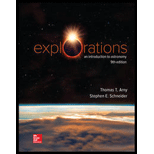
The reason for which the round shape of Earth and whether Earth perfectly spherical or not.
Answer to Problem 1QFR
The round shape of Earth is because of gravity. The Earth is not perfectly spherical. It is of the shape oblate spheroid.
Explanation of Solution
Gravity is the fundamental reason behind the shapes of planets, stars, and galaxies. Every object having mass possesses its own gravity and as far as a planet is concerned, its gravity tend to pull the matter in it equally from all directions. This pull from the center to the edges is just like the spokes of the wheel of a bicycle.
The equal pull towards all directions outward the planet makes the overall shape of the planet to be round in nature. Due to spinning, the extent of gravitational pull is high at the equator and hence there is a bulging at the equatorial region of Earth. This gives an oblate spheroid shape for Earth rather than a perfect spherical shape.
Want to see more full solutions like this?
Chapter 6 Solutions
Loose Leaf For Explorations: Introduction To Astronomy
- Give four ways to demonstrate that Earth is spherical.arrow_forwardIn a part of Earth’s orbit where Earth is moving faster than usual around the Sun, would the length of the solar day change? If so, how? Explain.arrow_forwardConsider a calendar based entirely on the day and the month (the Moon’s period from full phase to full phase). How many days are there in a month? Can you figure out a scheme analogous to leap year to make this calendar work?arrow_forward
- Is the Earth spherical or flat, and if it is spherical, prove this by using mathematical equations that include this proofarrow_forwardThe earth revolves around the sun in exactly 365 1/4 days which is equivalent to 1 year. To make up for the loss of 1/4 day, the calendar was adjusted so that we have a leap year for every 4 years. If the earth were to speed in its motion slightly so that a year would be completed in exactly 365 days and 6 hours, how often would we need to have a leap year?arrow_forwardGiven that Earth is about 4.6 billion (4.6 x 10%) years old, how many precessional cycles have occurred?arrow_forward
- It is estimated that the mass of the earth is 5.98 x 1024 kg; its mean radius is 6.38 x 106 m. Find its density in gm/cm³ and lbm/ft³. Compare this value to the density of water (62. 4 lbm/ft³).arrow_forwardIf Earth rotated once every 48 hours, and everything else was the same, which of the following statements would not be true? High tide would happen less frequently. The length of a day would be longer. The length of the year would be longer. The daytime temperatures would be higher on average. There would still be summer and winter in the temperature zones.arrow_forwardSuppose you need to find the height of a tall building. Standing 15 meters away from the base of the building, you aim a laser pointer at the closest part of the top of the building. You measure that the laser pointer is 7 degreestilted from pointing straight up. The laser pointer is held 2 meters above the ground. How tall is the building?arrow_forward
 An Introduction to Physical SciencePhysicsISBN:9781305079137Author:James Shipman, Jerry D. Wilson, Charles A. Higgins, Omar TorresPublisher:Cengage Learning
An Introduction to Physical SciencePhysicsISBN:9781305079137Author:James Shipman, Jerry D. Wilson, Charles A. Higgins, Omar TorresPublisher:Cengage Learning AstronomyPhysicsISBN:9781938168284Author:Andrew Fraknoi; David Morrison; Sidney C. WolffPublisher:OpenStax
AstronomyPhysicsISBN:9781938168284Author:Andrew Fraknoi; David Morrison; Sidney C. WolffPublisher:OpenStax Stars and GalaxiesPhysicsISBN:9781305120785Author:Michael A. Seeds, Dana BackmanPublisher:Cengage Learning
Stars and GalaxiesPhysicsISBN:9781305120785Author:Michael A. Seeds, Dana BackmanPublisher:Cengage Learning



